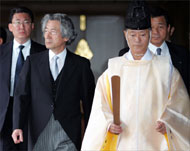Japan’s lionheart bids farewell
Politically, economically and socially, the Japan of 2006 is a very different country from the one that Junichiro Koizumi inherited when he became prime minister in April 2001.

With the curtain falling on the last act of Koizumi’s reign on September 26, opinions are inevitably divided on his failures and successes, but few can deny that he has introduced a splash of colour to the nation’s political proceedings.
Unthinkable before he was first elected, 64-year-old Koizumi has let the leader-as-media star genie out of its bottle and, as other heads of state such as Tony Blair and Bill Clinton have found out, it will be difficult to coax it back again.
“From the outset, he has been very good in front of the cameras and that is a lead that any politician who wants to come after him will have to follow now,” Noriko Hama, a professor of economics at Kyoto‘s Doshisha University, told Aljazeera.net.
Pivotal changes
In the five years and five months of his tenure, several areas of Japanese society and politics that were previously considered to be untouchable have been rendered almost unrecognisable, according to Go Ito, a professor of political science at Tokyo‘s Meiji University.
“Koizumi has initiated many changes, all of which are important in their own way and have a wide-ranging impact on the general public, but if I had to choose a single one it would have to be the impact he has had on domestic politics with his dismantling of the faction system of his Liberal Democratic Party,” said Ito.
The longest-serving Japanese leader for more than two decades, Koizumi had long intended to shed the factionalism of the party and end the sometimes murky tradition of cash in return for electoral support, particularly through the construction industry.
By doing so, he could also weaken the faction headed by one of his predecessors as party leader and an implacable enemy up until his death in July, Ryutaro Hashimoto.
Moves were already under way to achieve that, but Koizumi seized his opportunity by dissolving the 252-seat lower house of parliament in August last year when rebel members of his party opposed passage of a bill to privatise the post office.
Describing them as the “old guard” that wanted to protect the system of patronage politics of the past, he forced 14 to leave the party and won a resounding victory in the general election in September – with the opposition Democratic Party of Japan paying the price for his popularity at the ballot box.
Even his critics admit that out-manoeuvring the older generation within the party was something of a master-stroke.
“He has got away with things – like stirring up the LDP – that no one else would even have tried to do,” said Hama of Doshisha University.
“It has caused a lot of soul-searching in the highest reaches of the party and brought about more transparency. One of Koizumi’s key legacies will prove to be leaving the old guard in such a mess.”
Japan’s resurgent economy
In the economic arena, he will go down in history as the prime minister who turned turn-of-the-century Japan from a virtual economic basket case – at least by its own high standards – back into a confident and powerful economic engine for the region and the world.
And the Japan Inc of today is certainly more prudent than it was in the 1980s, when silly money was thrown at equally silly projects.
 |
|
Koizumi leaves behind a Japan |
“For what he has achieved, I give Mr Koizumi very high marks,” said Nobuyuki Nakahara, a former member of the Bank of Japan’s Policy Board who was appointed by the outgoing prime minister to his economic advisory team.
“Most importantly, he was able to successfully resolve the issue of non-performing loans at mega-banks at the same time as the Bank of Japan stuck to its monetary policy of quantitative easing, which gained enough time for even the ‘zombie companies’ to resurrect themselves.”
Nakahara predicted back in 2002 that the recession would have been beaten by the end of 2004, at the latest, because of the speed at which bad loans – which some estimated had stood at Y110 trillion ($916 billion) at their peak – were being removed from balance sheets while around Y50 trillion in tangible fixed assets were being reduced.
“His greatest merit was being able to restore Japan‘s economy without adding much in public expenditure, as would have been the case under previous administrations,” Nakahara said, adding that his bold structural reforms and deregulation efforts are making progress, such as the privatisation of the post office, although for many projects “this is only the very early stages”.
Chat-show presenter?
There are some who believe that Koizumi will be content with a place on the back benches in the Diet, content to watch the hustle and bustle as one of the few prime ministers not hurried out of office by circumstances or his political foes. But Hama disagrees.
“He’s not the type to stay in politics to pull strings from the background, so I can see him becoming a chat-show presenter,” she said.
“He’s a populist and that’s just about his level. I’m sure he would attract some great speakers and get very good reviews. But I also think he would probably end up talking too much himself.”
And his replacement, Shinzo Abe, certainly has some very large shoes to fill.